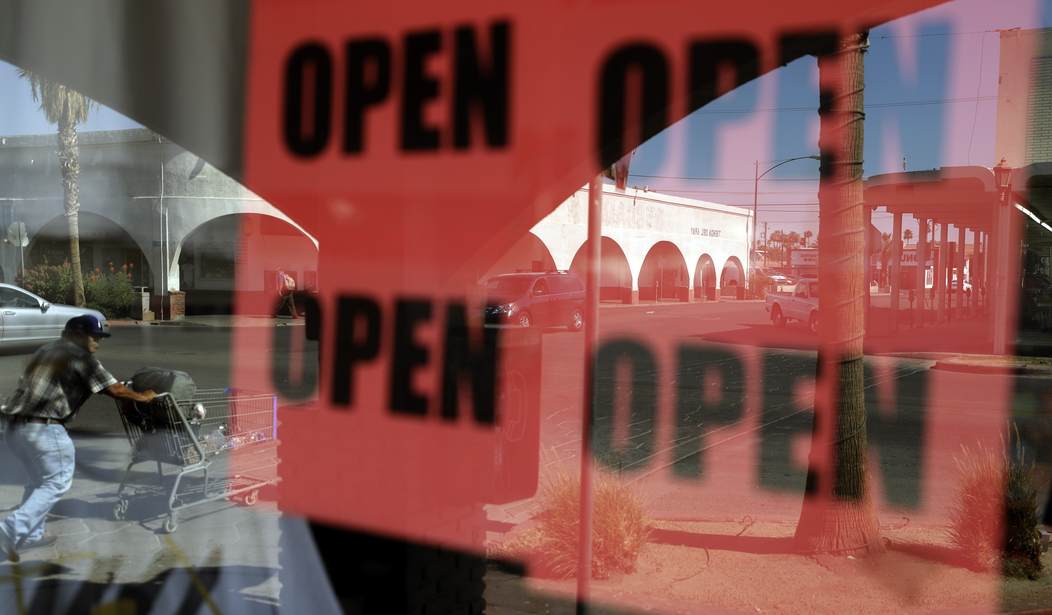Over the last few weeks, we’ve been left to wonder whether the sunnier economic metrics have more to do with a “sugar high” of government intervention or true organic growth. We have seen evidence in both directions, and the two are not mutually exclusive either. Part of the theory supporting injected stimulus is that even a sugar high can lead to organic growth by getting consumers more involved in economic activity.
Today’s reports on economic activity might not settle that question fully either, but the GDP report from the first quarter definitely shows the sugar high. The US economy grew at an annualized rate of 6.4% in Q1. This was driven by a double-digit increase in personal consumption expenditures (PCE), growing at four times the rate of the previous quarter as two different stimulus payments went out to most Americans:
Real gross domestic product (GDP) increased at an annual rate of 6.4 percent in the first quarter of 2021 (table 1), according to the “advance” estimate released by the Bureau of Economic Analysis. In the fourth quarter of 2020, real GDP increased 4.3 percent.
The GDP estimate released today is based on source data that are incomplete or subject to further revision by the source agency (see “Source Data for the Advance Estimate” on page 3). The “second” estimate for the first quarter, based on more complete data, will be released on May 27, 2021.
CNN strikes a cautious note, as they well should:
That was slightly more than what economists had predicted, and a faster rate than the 4.3% recorded at the end of 2020. In normal times, that 6.4% growth rate would represent electric growth. But during the pandemic, the situation has become quite different. After the disastrous contraction during the first wave of the pandemic last spring, America is still on the path to recovery.
The rampant growth of gross domestic product — the broadest measure of economic activity — is a good sign that the US economy is moving in the right direction, even though growth has slowed from the enormous 33.4% annualized jump in the second quarter of 2020 when the economy started to reopen.
That’s not the only reason for caution. Consumer spending, measured in PCE, rose 10.7% over 2020Q4, which had only increased 2.3% from Q3’s massive 41% spike in PCEs. That’s very clearly due to the $2000 in stimulus cash that went to the vast majority of American adults, but it’s worth noting that getting nearly twice as much stimulus as in April ($1200 per person) only produced one-quarter of the increase in consumer spending. Granted, we are talking about a higher basis level of spending on which to improve from Q2, but we can also look at PCE spending in real dollar terms as well (chained 2012 dollar value).
- 2020Q1: $13,118 billion
- 2020Q2: $11,860
- 2020Q3: $12,924
- 2020Q4: $12,999
- 2021Q1: $13,338
The first stimulus correlated to a growth of nearly $1.1 trillion in consumer spending. The second and third stimulus payments added only $339 billion in new spending. Perhaps we’ll see more of those impacts in Q2; after all, the most recent payment of $1400 came to people in the final month of the quarter, whereas the April 2020 stimulus payment came at the beginning. Still, $600 of it came right at the start, and despite it being half of the first stimulus payment amount, it only produced one-quarter of the bounce.
Another reason for worry is the 5% decline in gross private domestic investment. That follows two quarters of robust business investment (86.3% and 27.8%), although in annualized real-dollar terms, the Q1 number is still higher than the first three quarters of last year at $3.495 trillion. This seems like an unusual time for business investment to contract, as the vaccinations signal a surge toward reopening and the Biden administration proposes to rain even more stimulus on the economy.
The import/export balance is another worry. After two massive bursts of export growth, export sales declined by 1.1% in Q1. Imports, which enjoyed even bigger bursts of sales (which go to the detriment of GDP), grew at a slower-but-still-significant annualized rate of 5.7%. We’re still buying more than we’re making and selling, even in a global economy that got a lot more compartmentalized over the past year. Plus, it appears that some of the GDP growth came in renewed injection of federal dollars — a 13.9% annualized growth in federal spending, after two quarters of decline, as well as a 1.7% increase in state and local spending.
There are some good signs. Final sales of domestic product rose 9.2%, outstripping overall GDP by more than two points, suggesting that inventories got drawn down significantly in Q1. Final sales to domestic purchasers rose 9.8%. And disposable personal income rose 61.3%, likely in large part because of the stimulus — even if it didn’t get reflected in PCEs.
Plus, the news on weekly jobless claims continues to improve, if only incrementally:
In the week ending April 24, the advance figure for seasonally adjusted initial claims was 553,000, a decrease of 13,000 from the previous week’s revised level. The previous week’s level was revised up by 19,000 from 547,000 to 566,000. The 4-week moving average was 611,750, a decrease of 44,000 from the previous week’s revised average. This is the lowest level for this average since March 14, 2020 when it was 225,500. The previous week’s average was revised up by 4,750 from 651,000 to 655,750.
The advance seasonally adjusted insured unemployment rate was 2.6 percent for the week ending April 17, unchanged from the previous week’s unrevised rate. The advance number for seasonally adjusted insured unemployment during the week ending April 17 was 3,660,000, an increase of 9,000 from the previous week’s revised level. The previous week’s level was revised down by 23,000 from 3,674,000 to 3,651,000. The 4-week moving average was 3,684,000, a decrease of 23,250 from the previous week’s revised average. This is the lowest level for this average since March 28, 2020 when it was 3,611,750. The previous week’s average was revised down by 5,750 from 3,713,000 to 3,707,250.
We are now bumping along a new plateau in the 500K range, which is a big improvement over a couple of months ago but isn’t moving much since. The 500K range is still way too high for a healthy job market, but it’s at least familiar territory. The better news comes well down into the details of the Labor Department report, in which we find out that over 800,000 have come off the rolls of the pandemic assistance programs. We still have 12.4 million receiving benefits, which right now gives us a pretty good idea of the out-of-workforce overhang we will have for a long time to come. That may exist until Congress lets these programs expire and force people to get back into the labor force, at which point we’ll get a better idea of what our true unemployment picture looks like.








